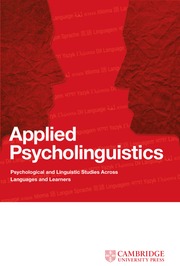Article contents
Summing up problems in bilingual specific language impairment: Why multiple influences may not be additive
Published online by Cambridge University Press: 11 March 2010
Extract
The Keynote Article is a very welcomed, timely, and incisive review article that examines theoretical and clinical implications of research on bilingual development and specific language impairment (SLI). Paradis provides a considered examination of the available evidence and takes into account a number of potential influencing factors. In particular, I want to commend her discussion of potential compensatory mechanisms that may play a role in bilingual development in SLI. This is often a neglected area in discussions concerning SLI. I also want to highlight that I agree wholeheartedly with her conclusion that the evidence to date “leans toward a positive attitude toward dual language learning for children with SLI who are in a supportive context for bilingualism.” This message is by no means universally accepted, nor is it put into action in therapeutic contexts across the United Kingdom and Europe. There is still much debate as to what type of advice should be given to parents and what the target language or languages of therapy should be (Harulow, 2008). This review article has therefore the potential not only to make a significant contribution to theory but also to practice.
- Type
- Commentaries
- Information
- Copyright
- Copyright © Cambridge University Press 2010
References
REFERENCES
- 1
- Cited by




